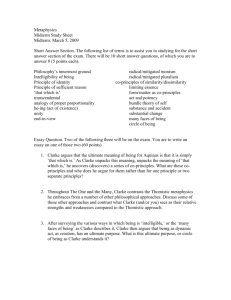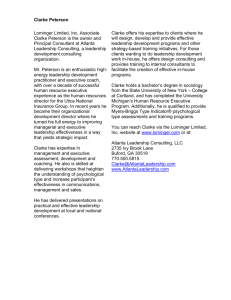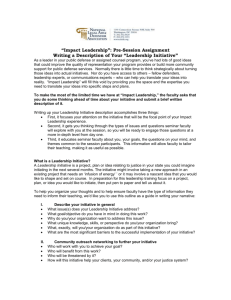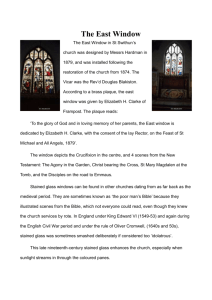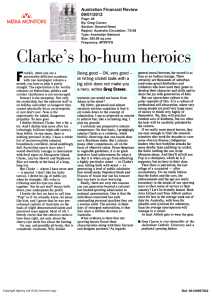Creating Competitive Advantage
advertisement
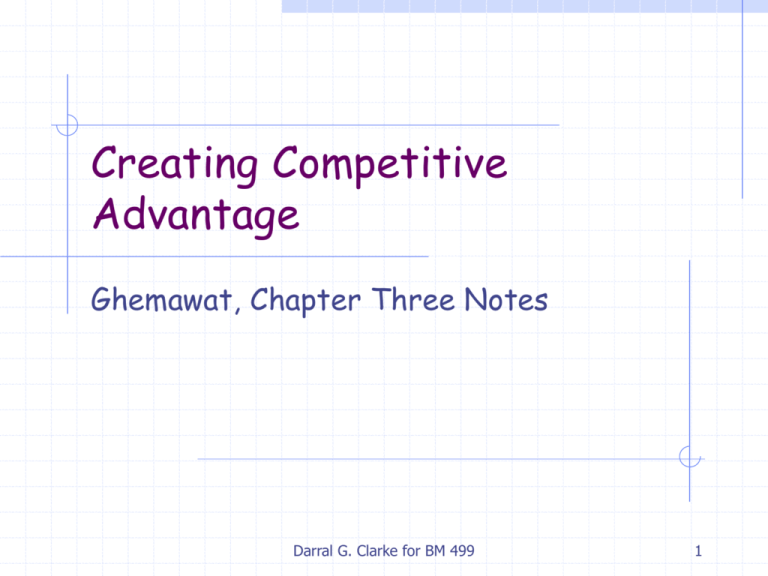
Creating Competitive Advantage Ghemawat, Chapter Three Notes Darral G. Clarke for BM 499 1 Average Economic Profits in the Steel Industry, 1978 -1996 ROE-Ke Spread 40% Great Northern Iron 30% 20% Worthington Inds Nucor Steel Technologies Oregon Mills 10% Commercial Metals 0% Carpenter Birmingham British Steel PLC Cleveland-Cliffs Quanex Lukens ACME Metals Ampco (10%) USX-US Steel Inland Steel (20%) (30%) $0 $1 $2 $3 $4 Average Invested Equity ($B) $5 $6 $7 $8 $9 $10 Armco WHX Bethlehem $11 $12 $13 $14 $15 Source: Compustat, Value Line, Marakon Associates Analysis Darral G. Clarke for BM 499 2 Average Economic Profits in the Drug Industry, 1978 -1996 ROE-Ke Spread 60% SmithKline 40% Glaxo American Amgen Home Products Merck 20% Schering Plough Watson Rhone-Poulenc Mylan Labs Bristol Warner Lambert Myers Eli Lilly Pfizer Perrigo Pharmacia & Upjohn Forest Labs Alza 0% ICN Scherer Ivax Genetech Biogen Roberts Genzyme Dura Chiron Cephalon Gensia Cygnus Immunex (20%) (40%) (60%) Average Invested Equity ($B) (80%) $0 $5 $10 $15 $20 $25 $30 Source: Compustat, Value Line, Marakon Associates Analysis Darral G. Clarke for BM 499 3 Calibrating Profit Drivers Residual Industry Corporate Source: Richard P. Rumelt, “How Much Does Industry Matter?,” Strategic Management Journal, 1991; 12:167-185 Positioning Darral G. Clarke for BM 499 4 Added Value Added value = total industry value created with the firm in the game - total value created without the firm in the game OR EQUIVALENTLY the value that would be lost to the industry if the firm disappeared Under unrestricted bargaining, a firm cannot capture more than its added value If you (in your relationships with customers and suppliers) create no value, you can capture no value More generally, if a firm (in its relationships) creates no new value, it had better have some clever way of claiming value Darral G. Clarke for BM 499 5 Value Creation Customer Firm Supplier • Value is created by a business operating together with its customers Willingness to pay and its suppliers – A firm does not create value in isolation • Willingness to pay = the most that a customer will pay for a firm’s product Total value created • Supplier opportunity cost = willingness to receive = the least that a supplier will accept for the resources required to make a product • The value created by a transaction is the difference between the Supplier opportunity cost customer’s willingness to pay and the opportunity cost of the resources Darral G. Clarke for BM 499 6 Value Division Customer Willingness to pay Value captured by customer Price Firm Value captured by firm Cost Value captured by supplier Supplier Supplier opportunity cost Darral G. Clarke for BM 499 7 Activity Analysis of Competitive Advantage Added value => goal is to drive a wedge between willingness to pay and (supplier opportunity) cost Indeed, a wider wedge than competitors achieve Problem: a firm must often incur higher costs to deliver a better product or service Partial solution: use activity analysis to spot opportunities to widen the wedge Darral G. Clarke for BM 499 8 McKinsey’s Business System Technology Design Development Manufacturing Procurement Assembly Distribution Transport Inventory Marketing Retailing Advertising Service Parts Labor Source: Carter F. Bales, P.C. Chatterjee, Donald J. Gogel, and Anapam P. Puri, “Competitive Cost Analysis,” McKinsey & Co. Staff Paper (January 1980) Darral G. Clarke for BM 499 9 Value Chain for an Internet Start-Up Firm Infrastructure Support Activities • Financing, legal support, accounting Human Resources • Recruiting, training, incentive system, employee feedback Technology Development • Inventory system Procurement • CDs • Shipping • Computers • Telecom lines • Inbound shipment of top titles • Warehousing • Server operations • Site software • Pick & pack procedures • Site look & feel • Return procedures • Customer research Inbound Logistics • Billing • Collections Operations • Shipping services • Picking and shipment of top titles from warehouse • Shipment of other titles from thirdparty distributors Outbound Logistics •Medi a •Pricing • Returned items •Promotions • Customer feedback •Advertising •Primary •activities •Product information and reviews •Affiliations with other websites Marketing & Sales After-Sales Service Primary Activities Darral G. Clarke for BM 499 10 Porter’s Generic Strategies STRATEGIC ADVANTAGE STRATEGIC TARGET Uniqueness Perceived by the Customer Industry wide DIFFERENTIATION Low Cost Position OVERALL COST LEADERSHIP Stuck in The middle Particular Segment only FOCUS Source: Michael Porter, Competitive Strategy, 1980 Darral G. Clarke for BM 499 11 Small group exercise: Name the generic strategies in our cases Coca Cola PepsiCo Continental Can Crown Cork and Seal Darral G. Clarke for BM 499 12 Interplay between Cost and Differentiation price $ cost Industry average competitor 1. 2. Darral G. Clarke for BM 499 3. 13 Porter’s Generic Strategies Low cost leadership Differentiation Dc Ci Cc Di Cc Cc Ci Di Focus: Low cost or differentiation in a market segment. Darral G. Clarke for BM 499 14 Cost Leadership Strategy Deliver a GOOD product or service at the lowest possible cost Open a significant and sustainable cost gap over all competitors Create advantage through superior management of key cost drivers Translates into above-average profits with industry-average prices BUT Cost leaders must maintain product parity or proximity in satisfying buyer needs Cost leadership often requires making trade-offs with differentiation Darral G. Clarke for BM 499 15 Cost Drivers Scale Learning Pattern of capacity utilization Linkages Interrelationships Integration Timing Policies Location Institutional factors Source: Michael E. Porter, Competitive Advantage (New York: Free Press, 1985) Darral G. Clarke for BM 499 16 Common Pitfalls in Cost Leadership Misunderstanding of actual costs False perception of cost drivers Focus on manufacturing Failure to exploit linkages Inadequate proximity to differentiators Ignoring competitor behavior Poor implementation Acting incrementally No cost management program Darral G. Clarke for BM 499 17 The Differentiation Strategy Select one or more needs that are valued by buyer Achieve and sustain superior performance by meeting these needs uniquely Selectively add costs if necessary to do so Successful differentiation leads to premium prices Differentiators must pick cost-effective forms of differentiation Differentiation leads to above-average profitability provided the firm maintains cost parity or proximity to competitors Darral G. Clarke for BM 499 18 Common Pitfalls in Differentiation Creating differentiation that buyers do not value Over-fulfilling buyer needs Looking too narrowly at the sources of differentiation Charging an excessive price premium Failing to understand costs of differentiation Ignoring signals of value Failing to recognize buyer segments Creating differentiation that competitors can emulate quickly or cheaply Darral G. Clarke for BM 499 19 Focus Strategy Exploits the same fundamental types of competitive advantage Selects narrow target segment(s) with unusual needs Creates optimal strategy for the target Narrowing of scope creates cost or differentiation advantage Darral G. Clarke for BM 499 20 Can business do more than one? Overall Cost Leadership + Differentiation OR Sometimes consistent But requires defense against a competitor achieving one or the other Darral G. Clarke for BM 499 Focus Can have multiplyfocused entities in one company 21 Stuck in the middle A company can be stuck in the middle if A differentiator attempts to cut costs that are essential to its differentiation A low cost leader incurs costs, above those which are essential to its low cost position, which do not differentiate the product A focus company attempts to broaden its strategic target beyond the segments in which it has an advantage In other words, by incurring costs, or by cutting costs, or by pursuing markets that reduce the “wedge” Darral G. Clarke for BM 499 22 An Expanded Version of Generic Strategies Extend BCG framework to include a broader set of cost structures Extend Porter’s five forces to recognize a more diverse set of competitive environments Apply the economic theory of long run average cost Darral G. Clarke for BM 499 23 Cost/unit LRAC Review E x p e ri e n c e Scale E x p e ri e n c e New technology Experience advantages decline with volume, Scale advantages exhausted at optimal scale, If no change in technology, no advantage to volume Darral G. Clarke for BM 499 LRAC Volume 24 Strategy and long-run average cost Cost advantage from volume Low High Ability to differentiate product High Fragmented Profitable & Defensible Stalemate Volume Low Darral G. Clarke for BM 499 25 Competitive Strategy and Long Run Cost/Differentiation I Volume Industry Low cost leadership type markets There is an advantage in scale or technology Stalemate Industry Can’t differentiate Economies of scale, experience common to competitors No process innovation Darral G. Clarke for BM 499 26 Competitive Strategy and Long Run Cost/Differentiation II Fragmented Industry Differentiation is key competitive factor Niche strategy Volume in niches inadequate to achieve volume cost advantages Profitable and defensible industry Differentiated product Customer preference Low cost producer of differentiated product Transitory industry Cost advantage based on labor Cost advantage based on any other temporary advantage Darral G. Clarke for BM 499 27 Small group exercise: Provide an example of a cost leadership strategy in one of our cases (identify the company and provide some detail) Cola wars and beverage industry Coors and brewing industry Crown Cork and Seal DeBeers and the diamond industry Egghead and the retail industry Barnes and Noble, Amazon and the retail book industry Darral G. Clarke for BM 499 28 Small group exercise: Provide an example of a differentiation strategy in one of our cases (identify the company and provide some detail) Cola wars and beverage industry Coors and brewing industry Crown Cork and Seal DeBeers and the diamond industry Egghead and the retail industry Barnes and Noble, Amazon and the retail book industry Darral G. Clarke for BM 499 29 Small group exercise: Provide an example of a focus strategy (either cost or differentiation) strategy in one of our cases (identify the company and provide some detail) Cola wars and beverage industry Coors and brewing industry Crown Cork and Seal DeBeers and the diamond industry Egghead and the retail industry Barnes and Noble, Amazon and the retail book industry Darral G. Clarke for BM 499 30
